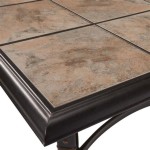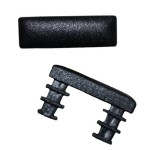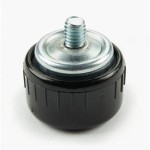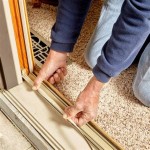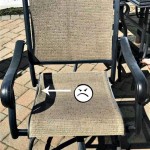Understanding the Andersen Patio Door Lock Mechanism
Andersen patio doors are a common feature in many homes, offering both aesthetic appeal and functional access to outdoor spaces. A critical component of their functionality is the locking mechanism, responsible for security and weather tightness. Understanding the intricacies of this mechanism is essential for homeowners to ensure proper operation, maintenance, and potential troubleshooting.
The Andersen patio door lock mechanism is designed to secure the door panel to the frame, preventing unauthorized entry and providing a tight seal against the elements. These mechanisms vary depending on the specific model and vintage of the patio door, but they generally consist of several core components working in concert. These components must be in good working order for the door to function as it's designed.
The overall effectiveness of the locking mechanism is directly related to the security and efficiency of the door itself. A malfunctioning or poorly maintained lock can compromise both the structural integrity of the door and the safety of the home. Regular inspection and preventative maintenance are, therefore, critical to extending the lifespan and performance of the Andersen patio door's locking system.
Key Components of the Andersen Patio Door Lock Mechanism
The locking mechanism of an Andersen patio door typically comprises several key components, each playing a crucial role in securing the door. Understanding these components will significantly aid in identifying potential problems and performing necessary repairs or maintenance.
The primary component is the lock cylinder, often referred to as the key cylinder. This is the component that interacts directly with the key, translating the key's rotation into a mechanical action. The lock cylinder is frequently made of brass or a similar durable metal and is designed to withstand wear and tear from repeated use. Damage to the lock cylinder can prevent the key from turning, rendering the entire locking mechanism inoperable. Lock cylinders can be complex, involving tumblers and pins that need to be aligned correctly for the mechanism to engage.
The multipoint locking system utilizes multiple locking points along the height of the door panel. These locking points engage with corresponding strikes in the door frame, providing enhanced security and a tighter seal against air and water infiltration. The multipoint system typically consists of rods or bars that extend from the central lock mechanism to the top and bottom of the door panel. These rods engage latches or bolts that secure the door in multiple locations simultaneously. Multipoint systems are designed to distribute locking pressure evenly across the door, preventing warping and enhancing security.
The lock handle, or actuator, is the component that the user interacts with to engage or disengage the locking mechanism. The handle is connected to the internal components of the lock, and its movement initiates the locking or unlocking process. The handle is usually made of metal or durable plastic and is designed for comfortable and ergonomic operation. Over time, the handle can become loose or damaged, affecting its ability to properly actuate the locking mechanism. The handle is often held in place by screws or bolts, which can loosen over time, requiring tightening or replacement.
Strike plates are metal plates that are installed on the door frame, opposite the locking points on the door panel. The latches or bolts from the locking mechanism engage with these strike plates to secure the door. Strike plates are typically made of steel or another durable metal and are designed to withstand repeated impact from the locking mechanism. The strike plates are crucial for ensuring that the locking points engage properly and securely. Misaligned or damaged strike plates can prevent the door from locking correctly.
Connecting rods, also sometimes called extension rods, are used in multi-point locking systems to transfer the motion from the central handle to the locking points at the top and bottom of the door. These rods are typically made of steel and are positioned within the door panel. They are designed to be durable and resistant to bending or breaking. When the handle is turned, the connecting rods move vertically, engaging or disengaging the locking points. If a connecting rod becomes bent or disconnected, it can prevent the locking mechanism from functioning properly.
Common Issues with Andersen Patio Door Lock Mechanisms
Despite their robust design, Andersen patio door lock mechanisms can experience issues over time. These issues can range from simple adjustments to more complex repairs or replacements. Identifying these problems early can prevent further damage and maintain the security of the door.
One common issue is difficulty in locking or unlocking the door. This can manifest as a stiff or resistant handle, a key that is difficult to turn, or the inability to fully engage the locking mechanism. This problem often stems from a lack of lubrication within the mechanism or the accumulation of dirt and debris. Over time, the internal components of the lock can become dry and corroded, leading to increased friction and difficulty in operation. Another potential cause is misalignment of the door panel relative to the frame, causing the locking points to bind against the strike plates. This misalignment can be caused by settling of the house or warping of the door frame.
Another frequent problem is a loose or wobbly handle. A loose handle can make it difficult to properly actuate the locking mechanism and can also be a sign of underlying issues. This looseness can be caused by worn or stripped screws that secure the handle to the door panel. Repeated use of the handle can cause the screw holes to enlarge or the screws to become loose, resulting in play in the handle. The handle itself might also be damaged or cracked, contributing to the wobble. Ignoring a loose handle can eventually lead to the complete failure of the locking mechanism.
Misalignment of the locking points and strike plates is another significant concern. If the locking points do not align correctly with the strike plates, the door will not lock properly, compromising security. This misalignment can be caused by settling of the house, warping of the door frame, or loose or damaged strike plates. Over time, the door frame can shift, causing the strike plates to move out of alignment with the locking points. Similarly, the door panel itself can warp, making it difficult to engage the locking mechanism. Regularly checking the alignment of the locking points and strike plates is crucial for maintaining the security of the door.
Broken or damaged internal components can also lead to functional problems with the Andersen patio door lock mechanism. The internal components of the lock, such as springs, levers, and rods, are subject to wear and tear over time. Springs can weaken or break, preventing the locking mechanism from fully engaging. Levers can bend or crack, affecting their ability to transfer motion. Rods can become bent or disconnected, disrupting the operation of the multi-point locking system. Identifying and replacing these broken or damaged components is essential for restoring the proper function of the lock.
Key issues are also a common complaint. A key might be difficult to insert, difficult to turn, or might not work at all. This can be due to a worn key, a damaged lock cylinder, or foreign objects obstructing the keyway. Over time, the key can become worn down, making it difficult to engage the tumblers in the lock cylinder. The lock cylinder itself can also become damaged or clogged with dirt and debris, preventing the key from turning smoothly. Attempting to force a key into a damaged lock cylinder can cause further damage, potentially requiring replacement of the entire locking mechanism. Also, the key might be the wrong key for the current lock cylinder if the locks have ever been changed.
Maintaining the Andersen Patio Door Lock Mechanism
Proper maintenance of the Andersen patio door lock mechanism is crucial for ensuring its longevity, security, and smooth operation. Regular maintenance can prevent many of the common issues that can arise and extend the lifespan of the lock.
Regular lubrication is a key aspect of maintenance. Applying a silicone-based lubricant to the moving parts of the locking mechanism can reduce friction and prevent corrosion. Lubricating the lock cylinder, handle mechanism, and locking points will help ensure smooth operation and prevent stiffness. It’s imperative to use a silicone-based lubricant rather than oil-based products, as oil-based lubricants can attract dirt and debris, potentially causing more harm than good. Applying lubricant every six months or as needed can significantly improve the performance of the locking mechanism.
Cleaning the locking mechanism is also vital. Over time, dirt, dust, and debris can accumulate within the locking mechanism, hindering its performance. Using a soft brush or vacuum cleaner to remove any accumulated debris can help keep the mechanism functioning smoothly. Avoid using harsh chemicals or abrasive cleaners, as these can damage the components of the lock. After cleaning, it’s important to re-lubricate the mechanism to ensure proper operation.
Checking and adjusting the alignment of the strike plates is a crucial maintenance task. If the strike plates are misaligned, the door may be difficult to lock or unlock. Loosening the screws that secure the strike plates and adjusting their position to ensure proper alignment with the locking points can resolve this issue. Once the strike plates are properly aligned, tighten the screws securely to prevent them from shifting. Also, ensure the screws are long enough to secure the strike plates to the frame.
Inspecting for worn or damaged parts is an important part of preventative maintenance. Regularly inspecting the locking mechanism for signs of wear or damage can help identify potential problems early on. Look for loose screws, cracked handles, bent rods, and worn strike plates. Replacing these worn or damaged parts promptly can prevent further damage and maintain the security of the door. Replacement parts can often be obtained from Andersen directly or from authorized dealers.
Finally, testing the locking mechanism regularly is recommended. Periodically testing the locking mechanism can help ensure that it is functioning properly and identify any potential issues before they become serious. Open and close the door several times, and engage and disengage the lock to ensure smooth operation. If you notice any difficulty in locking or unlocking the door, or any unusual noises, investigate the issue promptly. Regular testing can help you catch minor problems before they escalate into major repairs.
Handle And Locking Hardware For Hinged Inswing Outswing Patio Doors

Active Lock Mechanism 2594858 Andersen Windows Doors Locks Hinged Patio

A Series Hinged Door Active Panel 3 Point Lock Mechanism 9014688 Patio Hardware

Andersen Frenchwood Patio Door Active Multipoint Lock

8 Passive Lock Replacement Kit 2573471 Andersen Doors Handles 400 Series Hinged Patio Door

Lock Actuator 2579542 Andersen Windows Doors A Series Hinged Patio Door Hardware

7 6 A Series Hinged Patio Door Hardware

A Series Hinged Door Passive Panel 3 Point Hcr Lock Mechanism 9055469 Patio Hardware

Andersen Frenchwood Patio Door Active Multipoint Lock

Andersen Frenchwood Patio Door Active Multipoint Lock
See Also


